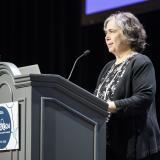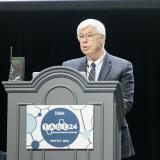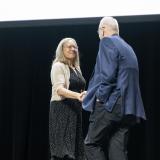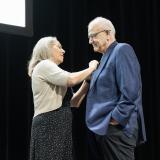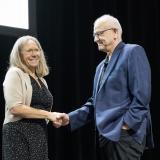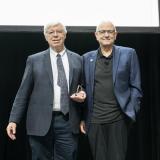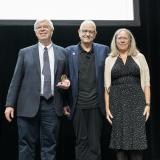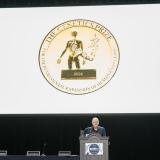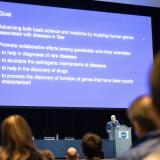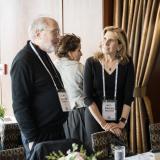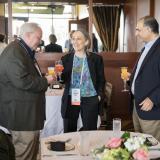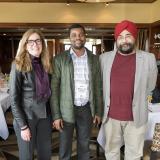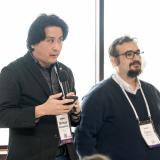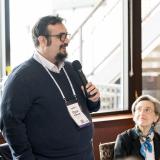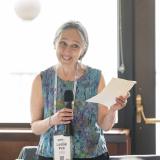2024 Gruber Genetics Prize
2024 Genetics Prize Recipient
Laureate Profile
Hugo J. Bellen obtained a master’s degree in business and engineering from the Solvay School of Business at the University of Brussels in Belgium. He then joined a research team in mathematical economics at the University of Antwerp where he modeled social welfare and wellbeing in Belgium. He became interested in veterinary medicine and obtained a doctoral degree from the University of Ghent. It was a genetics professor who introduced Bellen to what would become his lifelong pursuit: genetics. He applied to graduate programs in the United States and enrolled in the genetics program at the University of California at Davis. It was in John Kiger’s lab that Bellen found his lifelong pursuit: Drosophila genetics. After three years, he obtained his PhD and joined the lab of Walter J. Gehring at the Biozentrum in Basel, Switzerland as a postdoctoral fellow. This is where his passion to develop new technologies was born.
After a couple of years in the Gehring lab, Bellen accepted a faculty position at Baylor College of Medicine (BCM) in the Institute for Molecular Genetics, later becoming the Department of Molecular and Human Genetics. His research group conducted forward genetic screens using chemical mutagens and transposable elements to identify genes that affect the development of the PNS in embryos. This strategy was successful and yielded many genes that affect PNS development, including novel genes in the Notch signaling pathway.
Meanwhile, J. Troy Littleton, a graduate student in the Bellen lab, was interested in the mechanisms of synaptic transmission and introduced this topic to the lab. Troy’s research led to the discovery of the function of genes involved in synaptic vesicle exocytosis. This work was followed by the discovery of many genes that affect endocytosis by other lab members. Bellen continued with these multiple pursuits as they provided opportunities to understand nervous system function at a mechanistic level using genetics.
Bellen has developed new methods to study gene function and first performed screens using P-elements to tag and mutate genes based on the P-element mediated enhancer detection methodology. In collaboration with Allan Spradling’s team, they created a library of P-element insertions that cover more than 50% of all fly genes. Koen J.T. Venken, a graduate student in the Bellen lab, then developed two main new technologies: one based on Bacterial Artificial Chromosome technology and recombineering to transform flies with large constructs up to 250kB and one based on a Minos transposable element that allows highly efficient and precise manipulations of genes. This in turn let Oguz Kanca, a postdoctoral fellow, to develop a new technology based on CRISPR/Cas9 in which the yeast GAL4 gene is inserted into a fly gene. This novel gene tagging strategy creates a severe loss of function allele and allows expression of a UAS-cDNA under the control of the expressed GAL4. This strategy has been used to determine the expression pattern of thousands of genes and to create humanized fly models which express human cDNA of the orthologous genes to rescue the phenotypes caused by the loss of the fly gene. The Bellen lab has been open in sharing these resources and has empowered the work of hundreds of other researchers.
A graduate student in the Bellen lab, Shinya Yamamoto, and a team of students and postdoctoral fellows performed a genetic screen to identify genes that affect the development of the PNS as well as genes that are required for neuronal maintenance in adult flies. They identified 165 fly genes, required for either neuronal development or neuronal maintenance in adults; more than 90% have human orthologs and 65% are associated with human diseases. This screen led to the creation of the Model Organism Screening Center (MOSC) of the Undiagnosed Diseases Network to study rare and undiagnosed diseases in humans at BCM and the Duncan Neurological Research Institute at Texas Children’s Hospital, a collaboration with Shinya Yamamoto and Michael F. Wangler. The Bellen lab has used the CRISPR GAL4 technology to study numerous genes that have been identified in patients with rare genetic diseases, and the MOSC, in collaboration with physicians and genetic counselors from around the world, has already identified more that 40 novel disease-causing genes from undiagnosed individuals, solving some medical mysteries.
From these rare diseases, which often cause severe symptoms, Bellen’s research group has identified novel mechanisms that lead to more common neurodegenerative diseases, such as Alzheimer’s (AD) and Parkinson’s disease (PD). For AD, they have discovered that stressed neurons produce elevated levels of reactive oxygen species (ROS) that activate lipid synthesis in neurons. These lipids are peroxidated in neurons and transferred to glial cells where they form lipid droplets that protect neurons from ROS. However, prolonged ROS overwhelms glia and lead to their demise, followed by the demise of neurons. Many genes that have been implicated in AD affect this biological pathway. For PD, the Bellen team has shown that numerous genes that are implicated in PD or cause PD when mutated, lead to an elevation of ceramides, lipids that are associated with membranes and affect their properties. Interestingly, lowering ceramide levels can be very beneficial in flies. In summary, some genes that cause severe rare diseases when lost can be associated with common diseases when they partially lose their function.
Bellen is a member of the National Academy of Science, the US Academy of Arts and Sciences, and the EMBO. He was an HHMI investigator from 1989 to 2021. Bellen is also a celebrated mentor, having taught—and inspired—a generation of geneticists, many of whom are internationally known scientists.
Watch Video
Citation
The Gruber Foundation proudly presents the 2024 Genetics Prize to Hugo J. Bellen for ushering in a new era of model system genetics with direct impact on human disease.
Bellen developed novel techniques that allow human proteins bearing patient mutations to be expressed under the normal regulation of their Drosophila orthologs. Working in close collaboration with clinicians and basic scientists, Bellen and his partners have elucidated dozens of rare undiagnosed neurodevelopmental and neurodegenerative syndromes, providing new examples of how rare diseases can illuminate underlying mechanisms of more widespread conditions.
Bellen exemplifies the highest standards of quality, collegiality, and generosity in producing and widely sharing innovative genetic reagents and bioinformatic tools that have transformed Drosophila genetics.





